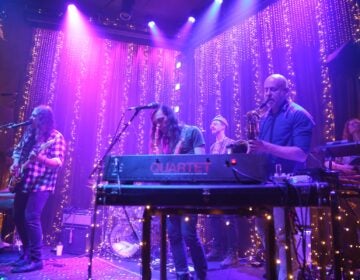Mighty Wanamaker pipe organ going strong in 100th year
For many lifelong Philadelphians, the Wanamaker Building means three things: the eagle, the Christmas show, and the pipe organ. On Wednesday, that organ turned 100 years old.
On June 22, 1911, the Wanamaker organ was first played to mark the coronation of King George V, happening that day in London. Rodman Wanamaker, the heir to the retail kingdom, was something of an Anglophile.
In his determination to bring music into his store, Wanamaker went big. Originally, the organ was installed with 10,000 pipes, but that was still too small for the building’s seven-story atrium. Over the years, more pipes were added, nearly tripling its size. It is considered the largest musical instrument in the world.
The organ almost didn’t make it this far. Ownership of the building and its organ changed hands many times, and the organ suffered for it. With scant attention to its maintenance and most of the pipe divisions shut off, the original console wasn’t working and the system was 75 percent inoperable.
“The history of this organ is such that it’s been played every business day since 1911,” said Peter Richard Conte, the grand court organist since 1989. “But it became really difficult to keep it going in the ’90s. It’s so neat to see the transformation and the care it’s getting.”
The care comes chiefly from Curt Mangel, the organ curator. For 10 years he has been repairing and tuning the 28,400 pipes, He says previous owners didn’t know what they had.
“When I came here, first working for Lord & Taylor, it was a matter of education,” said Mangel. “Macy’s gets it. They walked into this building and said, ‘What an incredible thing to have in one of our stores’ rather than, ‘What’s that doing here?’ Which is the normal attitude of most retail.”
Drawing fans from around the world
The Wanamaker organ is now fully operational, and enjoying an international reputation. A random sample page from the guestbook behind the console is signed by visitors from South Africa, New Zealand and the Netherlands.
Many organ enthusiasts have made pilgrimages to the Wanamaker to see her, hear her, and–if they are fortunate–touch her.
Charles Kegg, an organ maker from Ohio, came to Philadelphia on his own dime for the opportunity to help in its maintenance. He said the sound you hear in the heart of the organ is not pretty.
“You’re standing next to large pipes that are not designed to be heard individually,” said Kegg. “You can’t hear all the other stuff happening several stories above us that go along with it. It would be like standing in the back of the orchestra and with your ear in the tuba. But you get back in the audience and it sounds lovely.”
The organ actually sounds better now than when it did when it was new. Because the top several floors of the atrium have been glassed over and converted to office space, the acoustics have improved dramatically.
WHYY is your source for fact-based, in-depth journalism and information. As a nonprofit organization, we rely on financial support from readers like you. Please give today.




